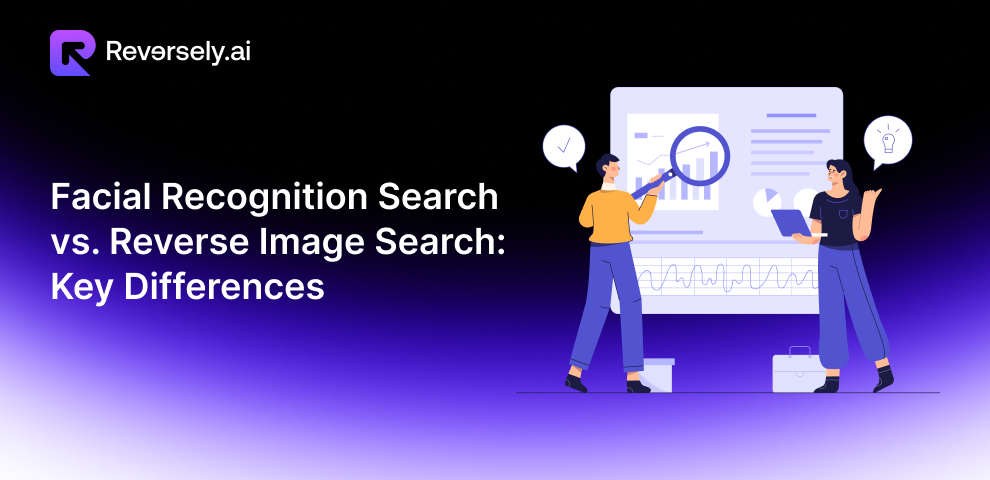
Image recognition is one of the best technologies from the past few years. It has enabled humans to identify objects, places, people, and text within images and videos.
This technology is used in several tools to make the search process easier. Face recognition and reverse image search are two of the most innovative tools in this regard. Both are used to detect images and their relevant information online. But they are used in different fields.
In this blog, we will discuss all the differences in these technologies. We will also look into their usage and applications. So, keep reading!
Face Recognition vs. Reverse Image Search
A facial recognition search is a technology that uses a digital image of a person’s face to search through a database of known faces. The goal is to identify the individual by comparing their facial features to a stored database of faces. In simple words, it is a way to find out who someone is by scanning their face in a picture or video.
Reverse image search is quite similar to face detection. This technology uses a sample image to find similar images, websites, and information online. It isolates different objects and elements in the images and compares them to an extensive database of images.
The Differences
Both image search technologies involve searching using a photo. However, there are many differences in their work and technology. Let’s have a look at all the differences.
The Purpose
The key difference between facial recognition and reverse image searches is their purpose. Face recognition specifically focuses on identifying individuals by their facial features within an image.
On the contrary, a reverse image search aims to find visually similar images overall. It does not necessarily focus on faces alone. Simply put, facial recognition is a specialized type of reverse image search that prioritizes facial features for identification.
Technology
Face detection technology uses complex algorithms and machine learning to analyze facial features. It uses computer vision to analyze visuals and extract information. It considers various elements in the image, such as the distance between the eyes or the shape of the jaw, face symmetry, high points of the face, etc, for conducting a search. Then, it creates a biometric profile for each photo and matches it across social networks and websites.
Reverse photo search is a content-based image retrieval (CBIR) query technique that recognizes patterns in visuals. It analyses the image’s visual features like colors, shapes, and pixel arrangements for information retrieval. It works quite similarly to face recognition. However, most of the searches are carried out using keywords and sample images.
How They Work?
Here is the step-by-step process of how these technologies work.
Face Recognition Search:
- Breaks down an image into smaller components like colors, shapes, and patterns
- Compares the components to a database of images
- Analyses the patterns and features in the image
- Classifies the objects in the image
- Fetch similar photos and data
Reverse Image Search:
- Extracts visual features from an image, like colors, shapes, and pixel arrangements
- Converts these features into a digital format that computers can use
- Matches the digital format of the query image to other indexed images
- Retrieves relevant visuals and their information
Database Comparison
A facial recognition search compares the extracted facial features against a database of known faces to identify a match. At the same time, the other one does not necessarily require a pre-existing database of individuals. It simply looks for visually similar images across the web.
Applications
Facial recognition systems are mostly used in the following fields.
- Identifying individuals in high-security areas like airports, government buildings, and banks to prevent unauthorized access.
- Matching suspects against a criminal database to identify potential criminals.
- Tracking employee attendance by automatically recognizing faces at work.
- Verifying identity for online accounts and services through facial scans.
- Identifying returning customers for personalized marketing and loyalty programs.
- Analyzing facial features to potentially identify genetic abnormalities or diagnose medical conditions.
- Targeting ads based on demographic information inferred from facial features.
- Using facial recognition to control home appliances and security systems.
To Sum Up
Image detection and recognition is an innovative development. It has drastically improved certain processes in many fields. This technology is used for image retrieval methods such as facial recognition search and reverse image search. Both use almost similar technology that analyses data to retrieve images. But their usage and purpose are a little different.
RIS is helpful for broader inquiries like searching the whole web to fetch imagery and all the relevant information. It also includes searching people’s faces to identify them. Face search is specifically developed to identify people. It conducts a deep search to determine the features of images accurately.